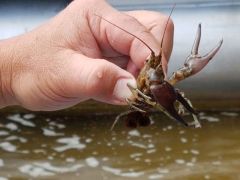 Rusty crayfish on Lake of the Woods in July. Photo courtesy of K. Keith.Crayfish are a common sight in this neck of the woods and are a highly sought-after crustacean worldwide, being rich in protein and low in fat. In fact, in Europe, they are considered a delicacy. Crayfish are omnivorous, so they feed on animals and plants, either living or decomposing. Some are native to this area, like the virile crayfish, but it’s just as likely that you’ll see a rusty crayfish, an invasive species that has become just about as common, if not more, than its native cousin.
Rusty crayfish on Lake of the Woods in July. Photo courtesy of K. Keith.Crayfish are a common sight in this neck of the woods and are a highly sought-after crustacean worldwide, being rich in protein and low in fat. In fact, in Europe, they are considered a delicacy. Crayfish are omnivorous, so they feed on animals and plants, either living or decomposing. Some are native to this area, like the virile crayfish, but it’s just as likely that you’ll see a rusty crayfish, an invasive species that has become just about as common, if not more, than its native cousin.
Rusty crayfish are large and aggressive and are actually native to the Ohio River Basin in the United States. According to the Ontario Federation of Anglers and Hunters, this species was likely introduced to Ontario by anglers from other areas who discarded crayfish they were using as bait. Rusty crayfish may also have been put in lakes or rivers by people who acquired them as pets or through the scientific supply trade. If you do a quick search of rusty crayfish on www.EDDmapS.org, you’ll see they are common in Lake of the Woods but have also been sighted on Trout Lake, Eagle Lake, Little Sand Lake and numerous lakes along the Canada/U.S. border towards the east. The first Ontario sighting of rusty crayfish was in the early 1960s in the Kawartha Lakes region of southern Ontario and the first confirmed report in the Lake of the Woods watershed was in Basswood Lake in 1991 (www.EDDMapS.org).
Rusty crayfish prefer clay, silt and gravel bottoms with rocks, logs or debris where they can hide. They eat large amounts of aquatic vegetation, which reduces spawning and nursery habitat for native fish. Females can carry up to 200 fertilized eggs under their tails, so a single female can introduce a new population to an uninfested area quite quickly. Once rusty crayfish are established, there is currently no practical way to permanently remove them. To prevent their spread, Ontario prohibits the overland transport of all species of crayfish, both alive and dead. Crayfish can only be used for bait in the waterbody in which they are caught.
The rusty crayfish’s large size, aggressive eating habits and rapid spread have had serious impacts on native species, reducing the native populations as the rustys outcompete them for food, directly predate on our native crayfish, fish, and fish eggs, and are better at protecting themselves from predation. Moreover, the rusty crayfish is known to hybridize with our native virile and northern clearwater crayfishes, further impacting our native biodiversity.
If you are unsure of which crayfish you are looking at next time you are out on the water, here are a few tips:
• Rusty crayfish are large; adults can reach 7.5 to 13 centimetres rostrum (part of shell in front of eyes) to tail.
• They have rusty patches on each side of the shell.
• They have grayish-green to reddish-brown claws with black bands near the tips.
• Their claws have an oval gap when closed.
• The rostrum (the part of the shell in front of their eyes) is smooth, pinched and distinctly concave.
See if you can tell the difference next time you spot some!
Most importantly, if you suspect you’ve encountered a rusty crayfish, take a photo, mark your location, and call the Invading Species Hotline at 1-800-563-7711 or report online at www.EDDMapS.org/Ontario. In Manitoba, go to www.Manitoba.ca/StopAIS or call 1-87-STOP AIS-0 and in Minnesota, go to www.EDDMapS.org or call 1-218-616-8102.
This series is provided as part of the International Watershed Coordination Program of the Lake of the Woods Water Sustainability Foundation (www.lowwsf.com).
Kelli Saunders, M.Sc., is the International Watershed Coordinator with the Lake of the Woods Water Sustainability Foundation
